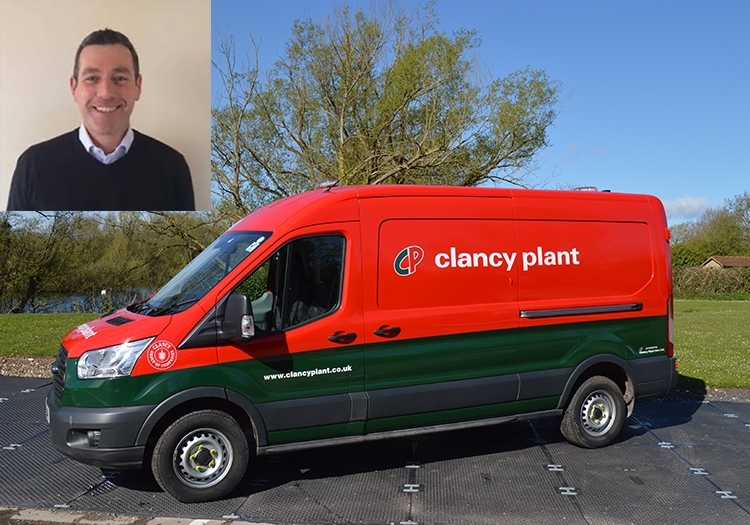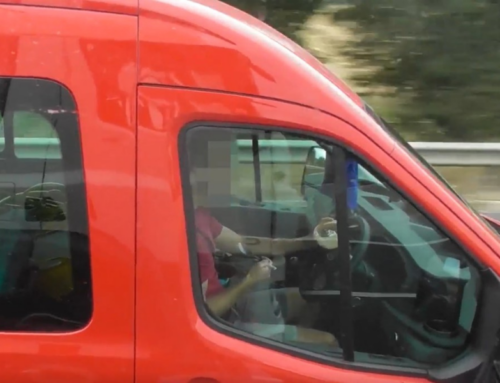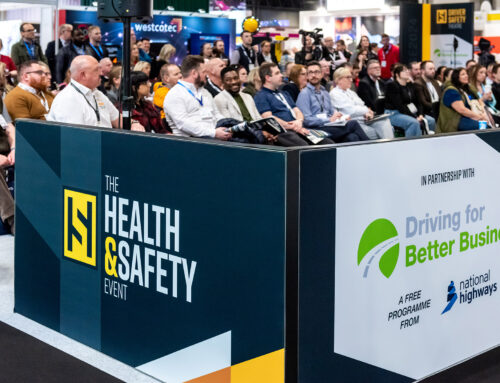There are many pros – and just a few cons – to life, when you’re responsible for fleet safety in a nationally-recognised firm operating 120 HGVs, 1,578 vans, 283 company cars, and a grey fleet of around 100.
Especially when you’re helping to drive a technological revolution that has placed the gathering and the analysis of immense amounts of data at the very epicentre of operations.
Colin Knight, 46-year-old Head of Fleet Safety Management and Compliance at Clancy Group, has helped pioneer an initiative under which ‘at risk’ drivers are equipped with a connected, forward-facing camera, monitoring their every move behind the wheel. And that means he never quite knows when a problem might crop up next.
“It’s fascinating,” says Colin, who lives near Ormskirk, in the North West. “The cameras monitor everything the driver does from g-forces on the vehicle, to braking and acceleration, even detecting incidents like a collision and the vehicle’s location. When something does occur, the camera software automatically sends out a report within minutes. It can show the 60 seconds building up to an incident, giving a clear picture of what led to the event. It’s highly instructional – even if the reports sometimes reach me when I’m not in the office!
“We make extensive use of that information not just to go over the incident with the driver, but as training material and intelligence for training others too. The big challenge is identifying precisely what data we have, how we are going to use it – and working out whether there are any additional data streams that we should be utilising.”
The big challenge is identifying precisely what data we have and how we are going to use it
And the highs that come with working for Clancy over the past 14 months since leaving his position as Fleet Safety Audit Manager at the Royal Society for the Prevention of Accidents? “I absolutely love my work,” says Colin, who spends much of his working week at Clancy Group’s Uxbridge offices.
“I live and breathe fleet and road safety and in my career I’ve worked for a number of organisations – often as a consultant – building my knowledge with firms such as Greggs and Argos, even including a period working in Cairo and the Middle East.
“Previously, I often worked as a consultant but I really wanted to work in-house for a blue chip company and that is what I have now done. One of the key moments since being with Clancy was getting backing from the board of directors. This is crucial because it’s all very well having a safety ethos but it needs to cascade from the top down,” says Colin. “Getting fleet safety management on the agenda and for it to be treated exactly the same as mainstream health and safety, and for senior management to buy into that, allowing the fleet safety team to operate without any handcuffs has been vitally important.”
Colin, whose hobbies include running and cycling, says it isn’t always that way with fleet safety in the industry at large. “People can pay lip service to it so that it becomes the poor relation to health and safety. But you are more likely to be involved in a road traffic accident than fall off a ladder or down a hole.
Fitting those cameras – part of a three-month driver development programme for higher risk drivers – has only been the tip of the iceberg for fleet safety at Clancy Group, where over the past 12 months, own-fault claims initially tumbled by 20 per cent (now steadying at 10 per cent), and fuel use has fallen by 7.9 per cent.
Identifying which drivers need the cameras – between 10 – 20 per cent are deemed to be at higher risk at any one time – takes hours of work. Drivers’ records must be closely analysed and patterns of behaviour discerned before action can be taken. Clancy’s plan for 2018 is to fit forward-facing cameras in all high-risk driver vehicles.
“One of our key preoccupations is using data to influence our targets and key performance indicators. We have an awful lot of fleet data coming through including licence checks, or driver style and behaviour, fuel usage, telematics reports, video footage from our forward facing cameras and so on,” says Colin.
“What we’re trying to do is use all that data to identify key risk groups and improve safety.”
It’s all very well having a safety ethos but it needs to cascade from the top down
Colin says that Clancy, the construction and multi utility services firm, has seen three key benefits arise from the cameras. “The first is that we can control 3rd party costs in terms of insurance claims. For instance if someone decides they want to slam on the brakes in front of our branded vehicle we can film that.”
“Secondly, it modifies the driver’s behaviour after a period of time. I put one in my vehicle and was acutely aware that I had to drive to the best of my ability at all times because I would be filmed.”
“Thirdly, we use the video footage or prompt investigation and training, because we can see the driver’s behaviour at the time and immediately before impact. It means we can tailor intervention to the problem, rather than just taking the driver’s word for it.”
Adds Knight: “I have been pushing this hard and have been very pleased with it. I think that technology like this is going to be a standard requirement with most vehicles in the near future. The days when you buy a VW or Mercedes or whatever make it is and then have to go and get the cameras, or telemetry separately, will come to an end, initially for commercial vehicles then for private ones too.
Other challenges facing Colin – as for any fleet safety professional – is clamping down on any potential overloading issues, and fostering a healthy respect for the Highway Code.
“We know what our vehicles weigh – and the weight of what we put in them. We just have to make sure that people don’t cut corners by overloading; it’s an important issue,” says Colin. So is obeying speed limits, he says.
To get the point across to its drivers, Clancy has again turned to the world of technology, replacing conventional on-paper toolbox talks with video toolboxes which, to date, have focused on speeding issues and ‘space’ – ensuring that drivers maintain a ‘bubble’ of safety around their vehicle, when they’re driving.
So which drivers present the biggest challenges? “Within our business the biggest age profile to look out for is 40-50 year-old van drivers and we have more van drivers than anything else.,” says Colin, whose long list of qualifications includes a diploma in advanced driving instruction from RoSPA, becoming a qualified fleet driver trainer and BSI Certified Lead Auditor for ISO 39001 Road Traffic Safety Management.
“Those individuals are in the highest risk category. The higher risk profile includes people identified for speeding and perhaps multiple collisions in the past. We do more checks on that now and we are looking at an online solution where we can pull all this data up very quickly, to make the most of it.”
Big challenges for 2018 include clamping down on driver fatigue
Traditionalists will be pleased to note that Clancy’s growing safety record is not all technology-based.
“Our key mission statement is to make life better for our families, that is the company ethos,” says Colin, who is also a member of the Institute of Master Tutor Drivers and a Driving Standards Agency Approved Driving Instructor. “The aim is to get people to realise that if they drive safely and within speed limits in work time, they are making life better for themselves and their families as they are less likely to be in collision. Also, they can take those skills and drive the same way when they are with their families at the weekend.”
Other big challenges for 2018 include clamping down on driver fatigue – again, through monitoring, in detail, driver records and telemetry – and ensuring that drivers adhere to the firm’s robust system of vehicle checks.
“We are very keen to communicate to the workforce that the job starts the minute you pick up the keys to your vehicle, and certainly before you drive out of the gates,” says Colin.
“It’s a big challenge to get van drivers to realise they are professional drivers. There is a mentality where some people see the van as a tool to get to site, then they start work. We’re trying to change that culture.”
Colin knows a thing or two about driver behaviour – he obtained a degree in that very subject from Middlesex University, nine years ago. And he is philosophical about human nature. “The biggest challenge we have is balancing safety with productivity. People will say ‘this is all very well and good but I still need to do eight jobs in different locations today’ so it comes down to good communication and getting middle management on board too.”
Admits Colin: “It would be true to say that the reception we get from our drivers is a mixed bag. But it is particularly pleasing that the majority of drivers are fully engaged, now, with the additional support they have received from my team, and are embracing the changes we are implementing right across the business.
“Everyone knows that following the rules is the right thing to do but obviously, whether that always takes place, hand on heart, who knows? All we can do is try to do our very best, to manufacture the situation where it does take place in the future.”
Colin Knight was talking to David Williams, award-winning transport and road-safety journalist, who writes for national publications including the Evening Standard, the Sunday Telegraph and Daily Telegraph.





